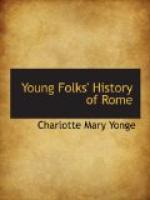[Illustration: CONSTANTINOPLE.]
There was now no danger in being a Christian, and thus worldly and even wicked men and women owned themselves as belonging to the Church. So much evil prevailed that many good men fled from the sight of it, thinking to do more good by praying in lonely places free from temptation than by living in the midst of it. These were called hermits, and the first and most noted of them was St. Anthony. The Thebaid, or hilly country above Thebes in Egypt, was full of these hermits. When they banded together in brotherhoods they were called monks, and the women who did the like were called nuns.
At this time there arose in Egypt a priest named Arius, who fell away from the true faith respecting our blessed Lord, and taught that he was not from the beginning, and was not equal with God the Father. The Patriarch of Alexandria tried to silence him, but he led away an immense number of followers, who did not like to stretch their souls to confess that Jesus Christ is God. At last Constantine resolved to call together a council of the Bishops and the wisest priests of the whole Church, to declare what was the truth that had been always held from the beginning. The place he appointed for the meeting was Nicea, in Asia Minor, and he paid for the journeys of all the Bishops, three hundred and eighteen in number, who came from all parts of the empire, east and west, so as to form the first Oecumenical or General Council of the Church. Many of them still bore the marks of the persecutions they had borne in Diocletian’s time: some had been blinded, or had their ears cut off; some had marks worn on their arms by chains, or were bowed by hard labor in the mines. The Emperor, in purple and gold, took a seat in the council as the prince, but only as a layman and not yet baptized; and the person who used the most powerful arguments was a young deacon of Alexandria named Athanasius. Almost every Bishop declared that the doctrine of Arius was contrary to what the Church had held from the first, and the confession of faith was drawn up which we call the Nicene Creed. Three hundred Bishops at once set their seals to it, and of those who at first refused all but two were won over, and these were banished. It was then that the faith of the Church began to be called Catholic or universal, and orthodox or straight teaching; while those who attacked it were called heretics, and their doctrine heresy, from a Greek word meaning to choose.
[Illustration: COUNCIL OF NICEA.]
The troubles were not at an end with the Council and Creed of Nicea. Arius had pretended to submit, but he went on with his false teaching, and the courtly Bishop Eusebius of Nicomedia, who had the ear of the Emperor, protected him. Athanasius had been made Patriarch, or Father-Bishop, of Alexandria, and with all his might argued against the false doctrine, and cut off those who followed it from the Church. But Eusebius so talked that Constantine fancied quiet




